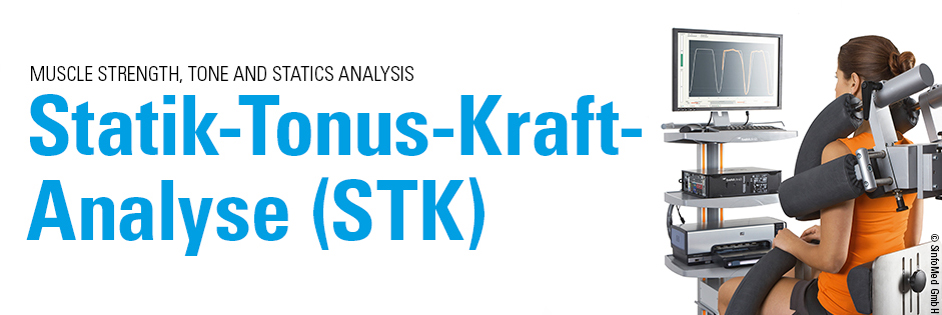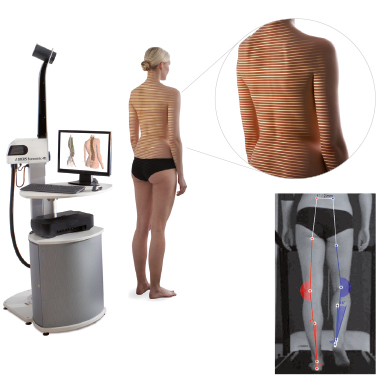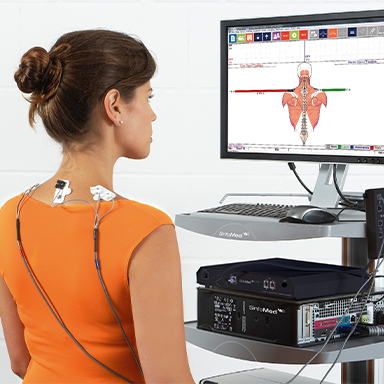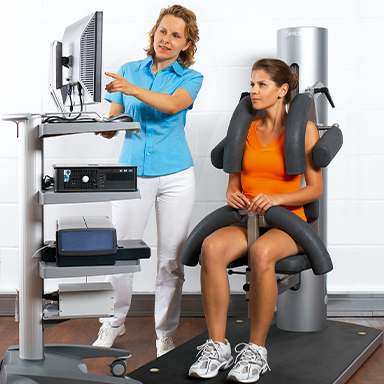An STF analysis (statics-tonus-force) is recommended for patients with shoulder and neck tensions, back pain due to muscular imbalances or intervertebral disc problems, muscular atrophy following a cruciate ligament injury, scoliosis or poor posture. For this purpose, three measuring methods are combined to obtain information on weakened or tense muscular areas and their degree of activity differences. The body statics measurement, muscle tone analysis and muscle strength analysis provide exact diagnostic data for all levels of movement (flexion/extension, lateral flexion and rotation in a left-right comparison).
WHEN IS THE TREATMENT APPLIED?
- Shoulder and neck tensions
- Back pain due to muscular imbalances or intervertebral disc problems
- Muscular atrophy after cruciate ligament injuries
- Scoliosis or poor posture
I. BODY STATICS MEASUREMENT
The 4D spinal column and posture measurement is used to analyze body statics. In a purely photo-optical procedure, a grid of lines is projected onto the patient's back and recorded by a video camera. Computer software analyzing the line curvatures then generates a digital image of the back surface. Based on this "virtual plaster cast" of the back, the spatial course of the spine and the position of the pelvis can be reconstructed. Also, a holistic picture of the body statics can be created in combination with a leg axis measurement. The measurements only take a few seconds and provide information on the entire postural apparatus: spinal curvature, vertebral body rotation, pelvic position and even muscular imbalances can be detected. An illustration of the results of analysis is enabling the patient to comprehensively understand their initial situation as well as therapeutic options for a compensation.
II. MUSCLE TONE ANALYSIS
Muscle tone analysis provides insight into one of the largest and most important functional mechanisms of the human body: the muscles. Surface electrodes, which are painlessly attached to the skin, allow for a precise analysis and assessment of the muscles’ condition and their activity. The analysis of the data provides information on weakened or tense muscular areas and their degree of activity differences, facilitating the specification of treatment and appropriate therapeutic measures. Furthermore, muscle tone analysis is informative regarding the muscle tone in a side comparison. Measurements are taken at rest and under various simple movements according to instructions. The muscle activity analysis is evaluated and makes for a valuable additional diagnosis.
III. MUSCLE STRENGTH ANALYSIS
Back pain is mainly caused by imbalances in the core muscles. These muscle shortenings and muscular atrophy lead to muscular imbalances, which in turn can cause disturbed muscle-joint relationships with consequences: painful muscle tension, overstraining of the tendons, muscular coordination disorders, muscular dysfunctions and increased wear of the articular cartilage. For this reason, muscle strength analysis is a highly efficient way of detecting and eliminating muscle strength deficits. An exact diagnosis of all movement levels is possible: flexion/extension, lateral flexion and rotation in a left-right comparison. The individual strength profile of each patient is illustrated in comparison to reference data. The following integrated biofeedback training module provides a precisely adjustable training, efficiently improving strength and coordination by means of different visual guidelines.
Our practice team will be happy to answer your individual questions. Therapy appointments can be arranged according to the indication by the doctors at our registration desk! This offer is an individual health service (IGeL) and will not be reimbursed by statutory health insurance companies.




